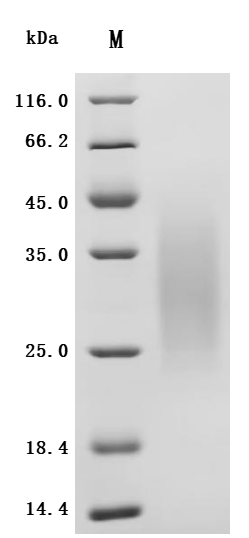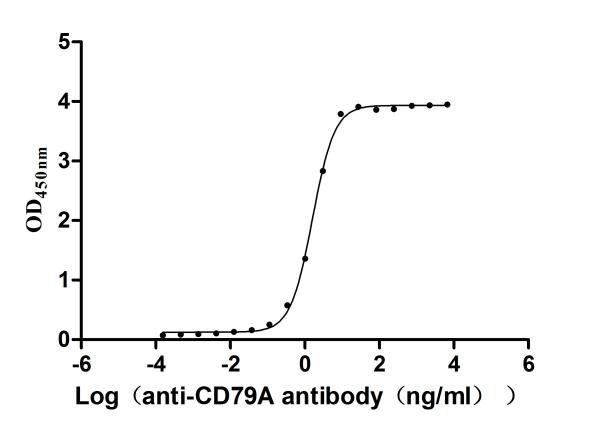The recombinant human CD79A protein is a human fragment protein that contains the 33-143 aa and is synthesized in mammalian cells. It carries a 10xHis tag at the C-terminus. The purity of the CD79A protein is over 90% as confirmed by SDS-PAGE. Its biological activity is assessed through a functional ELISA, where immobilized human CD79A at 2 μg/mL successfully binds to the anti-CD79A recombinant antibody (CSB-RA004957MA1HU), with an EC50 value ranging from 1.521 to 1.700 ng/mL.
The CD79A protein is a crucial B-cell receptor (BCR) signaling pathway component. It is primarily expressed in B lymphocytes and is essential in B-cell development, activation, and function. CD79A forms a heterodimer with CD79B, and together they are integral to the signaling mechanisms that activate B cells upon antigen recognition, which is vital for the adaptive immune response [1][2][3].
In the context of immune responses, CD79A is involved in tonic signaling, which is necessary for the survival and maturation of B cells. This signaling is critical during the transition of precursor B cells into mature follicular B cells, highlighting the importance of CD79A in early B-cell development [4]. Furthermore, CD79A expression has been linked to various clinical outcomes in cancers, particularly in breast cancer, where its expression correlates with a higher density of tumor-infiltrating lymphocytes (TILs) and improved patient survival rates in triple-negative breast cancer [5][6].
Moreover, CD79A has been implicated in the pathogenesis of several hematological malignancies, including classical Hodgkin's lymphoma and plasma cell myeloma, where its expression levels can affect disease progression and treatment responses [1][7]. In studies involving immune responses, CD79A has been shown to interact with various immune cells, influencing the overall humoral immune response and potentially modulating the effects of therapies such as BCG in bladder cancer [8][9].
References:
[1] S. Wang. Machine learning reveals diverse cell death patterns in lung adenocarcinoma prognosis and therapy, NPJ Precision Oncology, vol. 8, no. 1, 2024. https://doi.org/10.1038/s41698-024-00538-5
[2] Y. Feng, J. Hurst, M. Almeida-De-Macedo, X. Chen, L. Li, N. Ransom, et al. Massive human co‐expression network and its medical applications, Chemistry & Biodiversity, vol. 9, no. 5, p. 868-887, 2012. https://doi.org/10.1002/cbdv.201100355
[3] Q. Feng, W. Qin, & Y. Zang. Molecular mechanism of triple‑negative breast cancer‑associated brca1 and the identification of signaling pathways, Oncology Letters, 2019. https://doi.org/10.3892/ol.2019.9884
[4] X. Huang, K. Takata, Y. Sato, T. Tanaka, K. Ichimura, M. Tamura, et al. Downregulation of the b‐cell receptor signaling component cd79b in plasma cell myeloma: a possible post transcriptional regulation, Pathology International, vol. 61, no. 3, p. 122-129, 2011. https://doi.org/10.1111/j.1440-1827.2010.02634.x
[5] Y. Lv. Differential whole-genome doubling based signatures for improvement on clinical outcomes and drug response in patients with breast cancer, Heliyon, vol. 10, no. 7, p. e28586, 2024. https://doi.org/10.1016/j.heliyon.2024.e28586
[6] T. Velazquez-Caldelas. Coordinated inflammation and immune response transcriptional regulation in breast cancer molecular subtypes, Frontiers in Immunology, vol. 15, 2024. https://doi.org/10.3389/fimmu.2024.1357726
[7] C. He, S. Wang, C. Zhou, M. He, J. Wang, M. Ladds, et al. Cd36 and lc3b initiated autophagy in b cells regulates the humoral immune response, Autophagy, vol. 17, no. 11, p. 3577-3591, 2021. https://doi.org/10.1080/15548627.2021.1885183
[8] B. Ravenscroft. Increased stromal densities of b cells, cd103+ cells, and cd163+ m2-like macrophages associate with poor clinical outcomes in bcg treated non-muscle invasive bladder cancer,, 2023. https://doi.org/10.1101/2023.10.19.562817
[9] H. Hu. A breast cancer classification and immune landscape analysis based on cancer stem-cell-related risk panel, NPJ Precision Oncology, vol. 7, no. 1, 2023. https://doi.org/10.1038/s41698-023-00482-w
[10] L. Tribolet, C. Cantacessi, D. Pickering, S. Navarro, D. Doolan, A. Trieu, et al. Probing of a human proteome microarray with a recombinant pathogen protein reveals a novel mechanism by which hookworms suppress b-cell receptor signaling, The Journal of Infectious Diseases, vol. 211, no. 3, p. 416-425, 2014. https://doi.org/10.1093/infdis/jiu451








